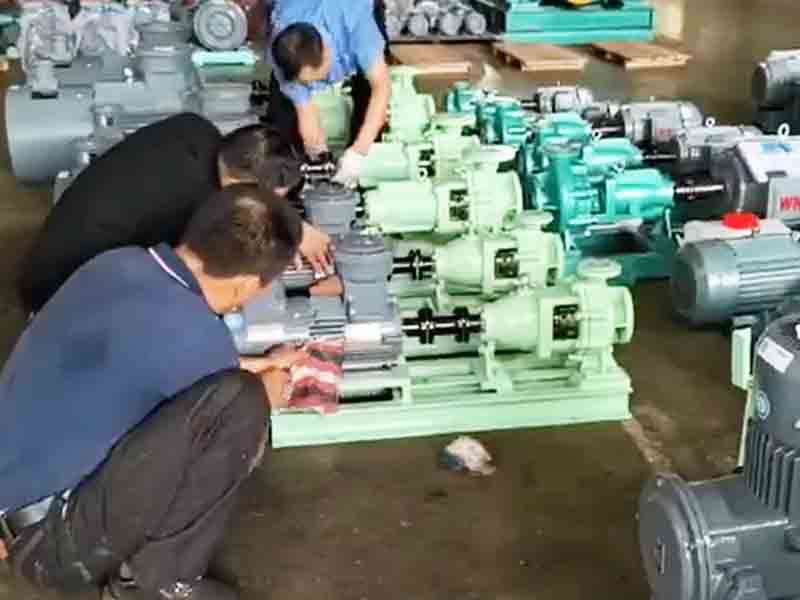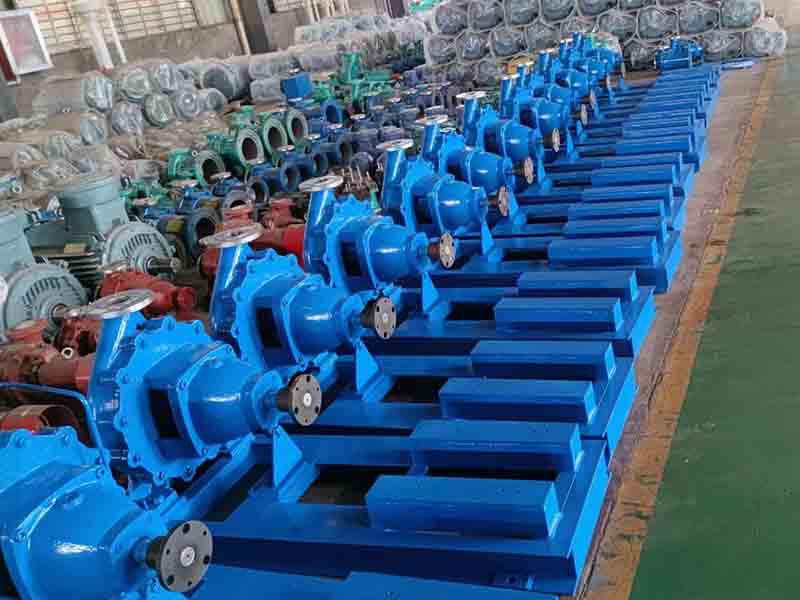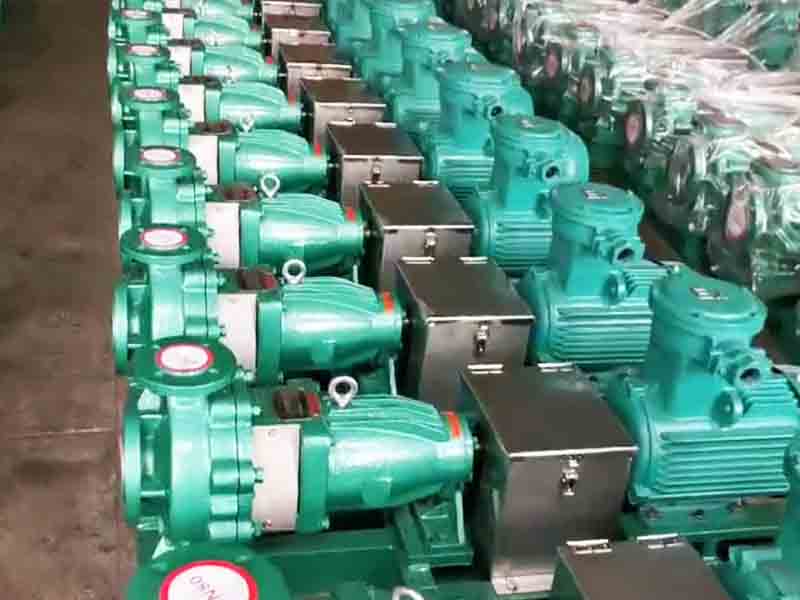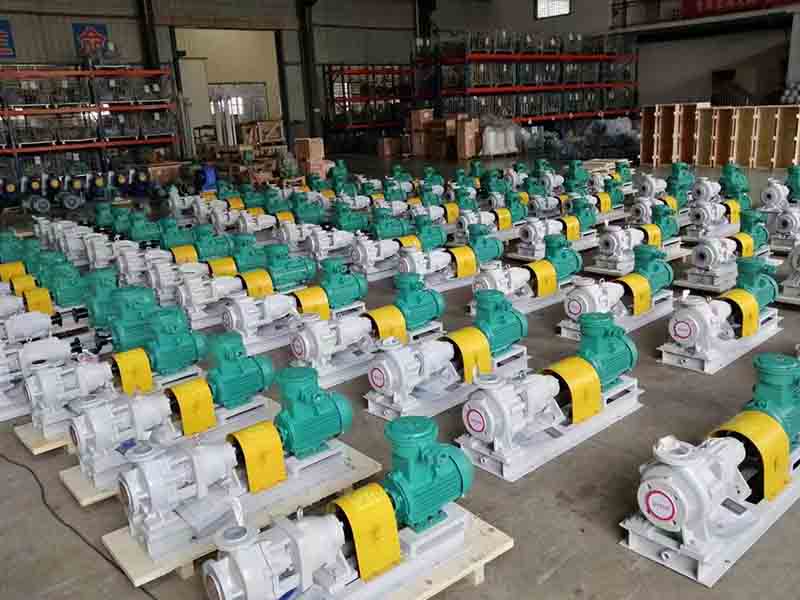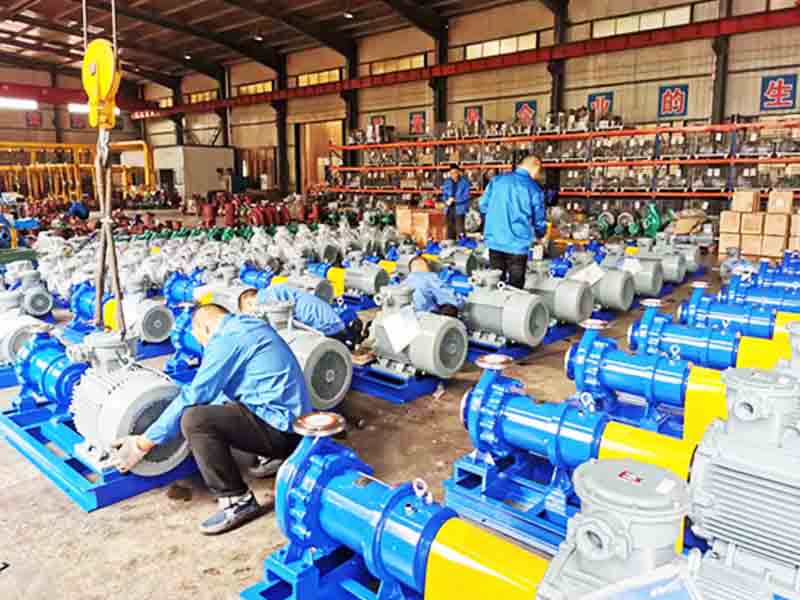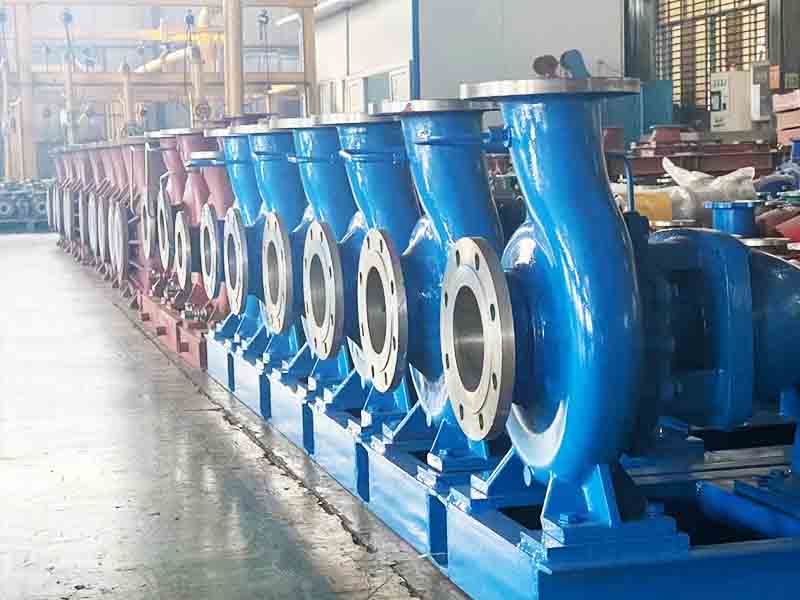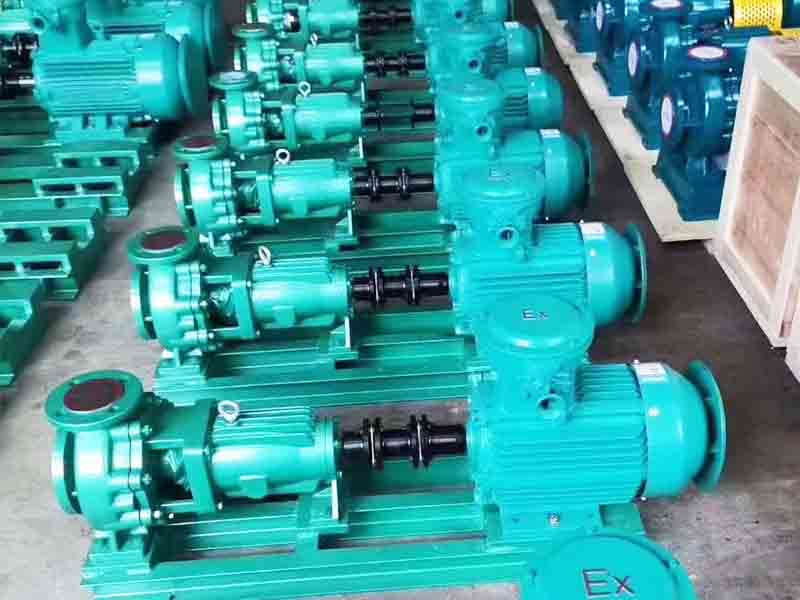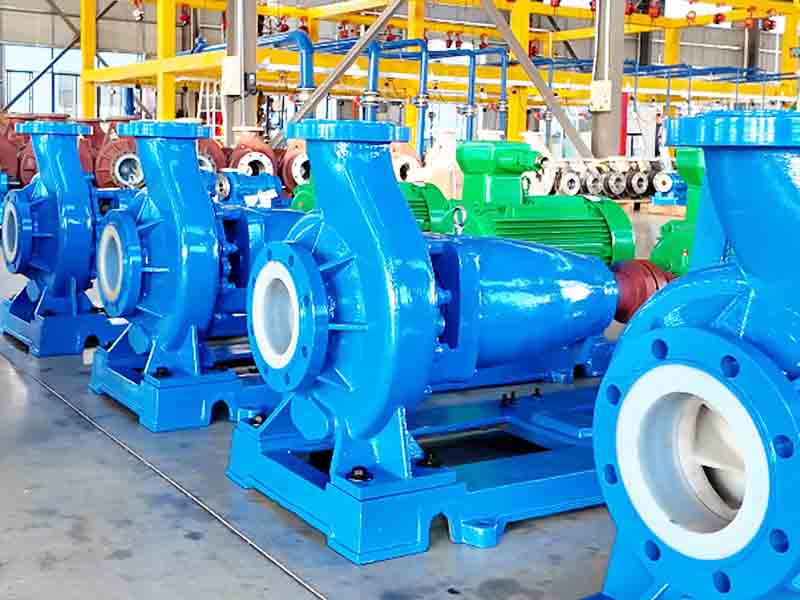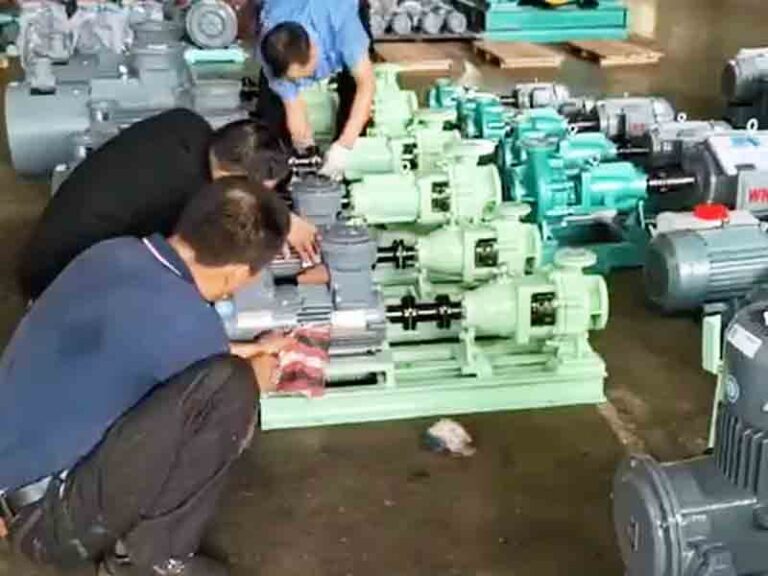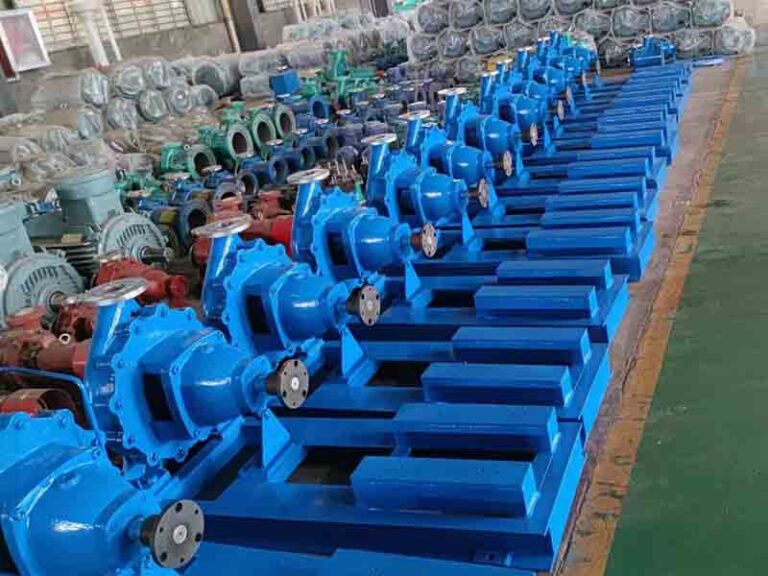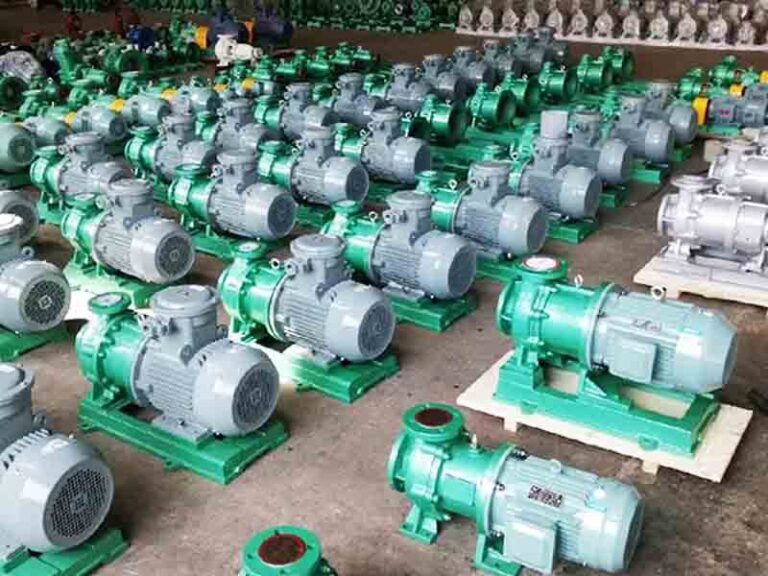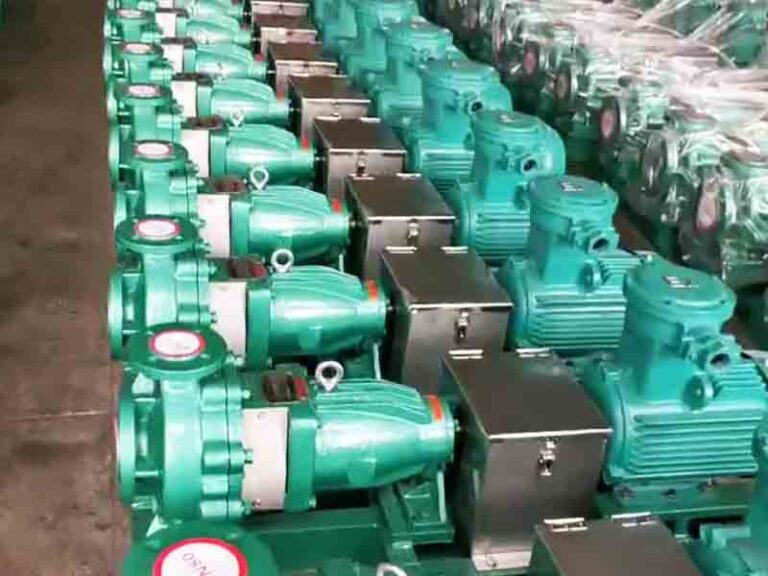Centrifugal pumps play a key role as important fluid transfer equipment in industrial production and various engineering projects. However, with the change of system requirements, often face the need to raise the centrifugal pump discharge pressure. This is not only about whether the equipment can meet the new work requirements, but also affects the operational efficiency and stability of the entire system. Next, we will discuss in depth to enhance the centrifugal pump discharge pressure related knowledge.
Working Principle of Centrifugal Pump
Impeller energy transfer
Standard Centrifugal pumps rely on the impeller to achieve the transportation of fluids. Impeller in the motor and other driving devices driven by high-speed rotation, the rotation of its own energy transfer to the fluid. This energy transfer is the core link of centrifugal pump work, and lays the foundation for subsequent fluid pressurization and transportation.
Fluid trajectory
When the fluid enters the centrifugal pump, it flows in the direction of the axis of the impeller. Subsequently, under the action of centrifugal force generated by high-speed rotation, the fluid is thrown out along the circumference of the impeller, through the tip of the impeller blades. In this process, the impeller not only enhances the speed of the fluid, but also increases the pressure of the fluid, and will be oriented to the outlet direction of the pump.
The role of the pump casing
The design of the pump casing is crucial. It first of all from the pump with self-priming inlet fluid to play a restraining role, to guide the fluid into the impeller in an orderly manner. When the fluid from the impeller thrown out, the pump casing is responsible for slowing down the speed of the fluid, and its effective control, and ultimately the fluid will be smoothly discharged from the pump body. It can be said that the pump casing in the whole fluid transfer process, to ensure the stability and efficiency of the fluid flow.
How To Increase Discharge Pressure Of Centrifugal Pumps
Impeller adjustment
Checking impeller trimming
In actual operation, it is necessary to check whether the impeller has been trimmed because it has previously met a specific requirement. If the impeller has been trimmed, it may result in the pressure it produces not being able to meet the current requirements of the new system.
Increasing impeller size to gain additional pressure
If it is found that the impeller has been trimmed in a way that affects the pressure output, consider increasing the size of the impeller. Larger impellers are able to exert a greater force on the fluid as it rotates, resulting in additional discharge pressure.
Trimming the Impeller to Reduce Excess Pressure
Conversely, if the current pump output pressure is too high for the system requirements, the impeller can be trimmed. By reducing the size of the impeller, the force on the fluid is reduced, which in turn reduces the discharge pressure of the pump to the appropriate range.
Maintenance based on maximum permissible pressure
It should be noted that durable centrifugal pumps have a maximum allowable discharge pressure based on pump performance, power and strength. Therefore, it is important to closely monitor the pump in daily use and perform regular maintenance. Doing so can identify potential problems in a timely manner to avoid equipment shutdown due to abnormal pressure, to ensure that the centrifugal pump is always in a safe and stable operating state.
Adjustment of pump speed
Ways to increase pump speed
Increase the pump speed is to increase the discharge pressure of one of the effective means. Specifically can be realized in a variety of ways, such as the use of variable speed drive device, which can flexibly adjust the pump speed to meet the demand for pressure under different conditions; can also be changed through the replacement of belts and pulleys to change the transmission ratio, so as to achieve the pump speed enhancement; in some extreme cases, when the existing motor can’t meet the requirements of the speed of enhancement, it may be necessary to replace the brand-new motor.
Limitations and effects of pump speed adjustment
Although by adjusting the pump speed to enhance the discharge pressure has certain limitations, such as by the motor power, mechanical strength of the equipment and other factors, but even a small adjustment of the pump speed, but also be able to have a significant impact on the performance of the self-priming positive displacement pump, thereby effectively enhancing the discharge pressure.
Eliminate piping obstruction
Elimination of pipeline obstruction factors
In the entire fluid transportation pipeline, there are a number of factors that may affect the pump performance obstruction, which unnecessary elbows and valves are more common. These obstructions will increase the resistance to fluid flow, resulting in the pump needs to consume more energy to overcome the resistance, thus reducing the overall performance of the pump.
Optimize piping to improve flow and pressure
Therefore, the piping needs to be carefully inspected to remove these unnecessary obstructions. At the same time, to ensure that the length of the hose is appropriate, to avoid too long or too short on the fluid flow to have a negative impact. By removing the piping obstruction, can effectively improve the flow of fluid, and according to the working principle of the efficient centrifugal pump, the increase in flow tends to bring about a rise in discharge pressure.
Check and deal with other key issues
Impeller corrosion inspection
Impeller in the long-term use of the process, may be corroded because of the corrosive nature of the transported fluid and other reasons. The surface of the corroded impeller is no longer smooth, and its force on the fluid will be affected, which will reduce the discharge pressure of the pump. Therefore, it is necessary to regularly check whether the impeller corrosion.
The correct filling of the pump
The correct filling of the pump is also the key to ensure its normal operation. If the pump is not properly filled, there may be air inside, which will lead to the occurrence of air binding phenomenon, so that the pump can not be normal suction and transportation of fluids, naturally can not produce enough discharge pressure. Therefore, ensuring that the centrifugal diesel pump is properly filled to remove internal air is an important prerequisite for increasing discharge pressure.
What Factors Affect Pump Discharge Pressure
Pump speed
Pump speed has a significant impact on the discharge pressure. In principle, the higher the pump speed, the impeller in a unit of time on the fluid to do more work, the energy obtained by the fluid is also the greater, so that the discharge pressure is higher; conversely, the lower the pump speed, the less energy obtained by the fluid, the lower the discharge pressure. Therefore, in practice, through the reasonable adjustment of the pump speed, can effectively control the discharge pressure.
Pump size
Pump size plays an important role in determining the discharge pressure. Generally speaking, larger size pumps are equipped with larger impellers and more powerful drives. This enables larger pumps to pressurize more fluid during operation and produce higher discharge pressures compared to smaller pumps. Therefore, when selecting the right size pump, you need to choose the right size pump according to the actual required pressure and flow rate.
Pump type
Different types of pumps, such as common centrifugal pumps and volumetric pumps, their pressure generating mechanism and capacity differences. Centrifugal pumps rely mainly on the rotation of the impeller to increase the kinetic energy and pressure energy of the fluid; while the displacement pump is through the periodic change of the studio volume to achieve the suction and discharge of the fluid, and generate pressure. Due to the difference in operating principles, they each have their own characteristics in terms of pressure capacity. In specific application scenarios, the right type of pump must be selected according to actual needs to ensure that the required discharge pressure can be obtained.
Fluid properties
Fluid properties, such as viscosity, density and temperature, etc., on the performance of the pump and the discharge pressure has a non-negligible impact. For example, the viscosity of the fluid in the flow of the need to overcome greater internal friction, which will lead to the pump in the process of conveying the need to consume more energy, so that the discharge pressure is reduced; the density of the fluid, the pump exerts the same force, resulting in a relatively small change in the pressure; and changes in temperature may affect the viscosity of the fluid and the density of the centrifugal electronic pump, and thus indirectly affect the discharge pressure.
Pipe Diameter and Length
The diameter and length of the pipe is also an important factor affecting the discharge pressure. Longer pipeline will increase the fluid in the flow process along the resistance, so that the fluid in the electric centrifugal pump in usa before reaching the exit of the loss of more energy, resulting in a lower discharge pressure; and narrower pipeline will increase the flow rate of the fluid, the local resistance increases, the same will also cause a decline in discharge pressure. On the contrary, a shorter or wider pipeline can reduce the energy loss of the fluid, which is conducive to improving the discharge pressure.
Inlet conditions
Pump inlet conditions, such as the presence of air or debris, etc., on the discharge pressure has a direct impact. If there is air at the entrance, air pockets will be formed in the pump, resulting in a reduction in the actual flow rate of the pump, the discharge pressure; and the presence of debris and other impurities may damage the pump impeller and other components, affecting the normal operation of the pump, which in turn affects the discharge pressure. Therefore, optimizing the inlet conditions of the pump to ensure that the inlet fluid is clean and free of air mixing is crucial to achieving optimal pump performance and stable discharge pressure.
How Is The Pump Discharge Pressure Controlled
Adjustment of pump speed
The direct relationship between speed and pressure
Pump speed is one of the key factors that directly affect the discharge pressure. According to the working principle of centrifugal pump, the change of rotational speed will directly lead to the change of the size of the work done by the impeller on the fluid, thus affecting the discharge pressure.
Adjustment of rotational speed in case of reflux
When there is a reflux situation in the system, the fluid flow state is abnormal, at this time the appropriate reduction in the pump speed, can reduce the pump’s output energy to the fluid, and then reduce the output pressure of the pump, so that the system pressure is restored to the normal range, to achieve the purpose of controlling the pressure of the type of centrifugal pump.
Adjust the pump inlet valve
The importance of the inlet valve on the pressure adjustment
Pump inlet valve plays an important role in regulating pump pressure. By changing the opening of the inlet valve, you can control the fluid flow and flow rate into the pump.
Valve Adjustment Operation in Case of Backflow
When the pump backflow phenomenon, reduce the opening of the inlet valve, can reduce the amount of fluid into the pump, reduce the speed of water flow. In this way, the pump in a unit of time to the fluid to do the work is reduced accordingly, thus reducing the output pressure of the pump, to achieve effective control of the pump pressure.
Installation of pressure control valves
Automatic adjustment principle of pressure control valve
Installation of pressure control valve is an effective way to realize the automatic adjustment of pump pressure. The pressure control valve can monitor the output pressure of the magnetic drive centrifugal pump in real time.
Action when the pressure reaches the set value
When the output pressure of the pump reaches a pre-set value, the pressure control valve will automatically perform the corresponding action to close the inlet valve of the pump. This operation makes the amount of fluid into the pump to reduce the pump output is reduced, thus realizing the automatic control of the pump pressure, to ensure that the output pressure of the pump is always maintained in the set range.
Control Precautions
Ensure that the pump is in proper working condition
Before any control operation on the pump pressure, the first task is to ensure that the pump is in a normal working condition. Only the pump itself is in good operating condition, the control operation can be effectively implemented, otherwise it may be due to this kind of centrifugal pump failure or damage and lead to reduced efficiency, or even cause more serious equipment problems.
Keep the pump running smoothly
In the process of regulating pump pressure, must pay attention to keep the pump running smoothly. Adjustment is too large or too frequent, will have a greater impact on the mechanical parts of the pump and wear and tear, affecting the normal operation of the pump, shorten the service life of the pump. Therefore, the operation should follow the principle of slow and smooth, and gradually adjust to the appropriate pressure value.
Attention to maintenance
Pump maintenance is essential to maintain its normal working condition. Regular cleaning of various parts of the pump, to prevent the accumulation of impurities affecting the performance of the components; check the wear and tear of the components, and timely detection of potential problems; for the parts that have been damaged, to be replaced in a timely manner. Through these maintenance measures, you can effectively improve the service life of the pump and work efficiency, for stable control of the stainless steel magnetic driven pump pressure to provide protection.
Adjustment according to actual demand
Different working environments and specific needs, requiring the use of different methods of controlling pump pressure. In the actual operation process, it is necessary to consider and select the most appropriate control method according to the actual working conditions of the site, such as the nature of the fluid, conveying flow requirements, piping layout and other factors, in order to achieve the best working results.
Attention to safety issues
Pumps as a mechanical device with greater power, there is a certain degree of danger in the process of use. In the corrosion-resistant magnetic pump pressure adjustment and other operations, the operator must maintain a clear mind, strictly comply with the safety regulations, pay attention to all kinds of safety matters. For example, to avoid direct physical contact with running parts, to prevent accidents caused by improper operation, to ensure the safety of personnel and equipment.
How Can The Pump Discharge Pressure Be Maintained
Reasonable selection of pumps
Selection according to flow and pressure requirements
When selecting centrifugal pumps, the flow and pressure required by the application scenario should be fully considered. If the selected pump is too small, the resulting pressure will not be able to meet the system requirements, resulting in the equipment can not work properly; and choose too large a pump, although it can meet the pressure requirements, but it will result in a waste of energy and increase operating costs.
Therefore, an accurate assessment of the flow and pressure requirements, select the appropriate specifications of the pump, is to ensure that the pump discharge pressure stability and economic operation of the basis.
Consider other relevant factors
In addition to flow and pressure, but also need to consider such as the nature of the fluid, the working environment and other factors. For example, when conveying corrosive fluids, you need to choose a corrosion-resistant material pump; work in a high-temperature environment, to choose a pump type that can adapt to high-temperature conditions.
Comprehensive consideration of these factors, in order to select the most suitable pump, to maintain a stable discharge pressure to provide protection.
Regular maintenance
Leakage check
Regular comprehensive inspection of the pump, including leakage is one of the key inspection items. Pump body, pipe connections and other parts may be due to aging seals, wear and other reasons for leakage. Once the leak is found, it should be repaired in time to avoid fluid leakage leading to pressure loss and affecting the normal operation of the pump.
Monitoring system performance
Through the installation of appropriate monitoring instruments, such as pressure gauges, flow meters, etc., real-time monitoring of pump operating parameters and system performance. Observe the changes in pressure, flow and other data to determine whether the pump is in normal working condition. If abnormal fluctuations in data are found, analyze the reasons and take appropriate measures to adjust.
Timely replacement of worn parts
During the operation of the pump, some parts, such as impeller, seals, bearings, etc., will gradually wear out due to long-term friction and mechanical stress. When these parts wear to a certain extent, it will affect the performance of the pump, resulting in a drop in discharge pressure and other problems.
Therefore, it is necessary to check the wear of the parts regularly, and for the parts with serious wear, replace them in time to ensure that the pump is always in the best performance state.
System monitoring
Installation of monitoring instruments
In order to accurately grasp the working status of the pump and discharge pressure, the need to install pressure gauges and flow meters and other monitoring instruments in the system. These meters can display the output pressure and flow data of the pump in real time, providing intuitive information for the operator.
According to the monitoring data adjustment
Operators should pay close attention to the data displayed by the monitoring instrument, according to the actual demand and system operation, the pump’s operating parameters for adjustment. For example, if the discharge pressure is found to be lower than the set value, appropriate adjustments can be made through the previously mentioned method of raising the discharge pressure to ensure that the pressure provided by the pump meets the system requirements.
Adjusting impeller size
Adjusting the Impeller to Pressure Requirements
In some cases, the pump discharge pressure can be effectively maintained by adjusting the impeller size. When the system requires a higher discharge pressure, the impeller can be replaced with a larger size. Larger impellers are able to do work on more fluid when rotating, thus increasing the output pressure of the pump; on the contrary, if the required pressure of the system decreases, the impeller can be replaced with a smaller size in order to reduce the output pressure of the pump.
Be aware of the impact of impeller replacement
It should be noted that the replacement of the impeller size is not only a simple replacement of parts, but may also have an impact on other parts of the pump, such as the load of the motor, the sealing performance of the pump body. Therefore, when replacing the impeller, these factors should be considered comprehensively to ensure that the entire pump system can operate stably.
Control system operation
Installation of Variable Frequency Drive (VFD)
Installation of variable frequency drive (VFD) is an effective way to control the operation of the system, VFD can be based on the actual needs of the system, the flexibility to adjust the speed of the pump. When the system demand for flow and pressure is low, the pump speed is lowered to reduce energy consumption; when the demand increases, the pump speed is increased to meet the system requirements.
Advantages of VFDs
Adjusting the pump speed through VFD not only realizes the purpose of energy saving, but also prevents the pump from running at unnecessarily high speeds, reducing the wear and tear of mechanical parts and prolonging the service life of the pump. At the same time, this precise speed control helps maintain a stable discharge pressure, ensuring reliable and efficient system operation.
What Safety Precautions Should Be Taken When Handling Pump Discharge Pressure
Wear protective equipment
Importance of protective equipment
In centrifugal pump operations involving high-pressure systems, wearing the proper protective equipment is a primary measure to safeguard the operator’s personal safety. Due to the potential hazards of fluid injection and flying debris in high-pressure systems, an accident may cause serious injury to the operator’s body.
Specific protective equipment requirements
Operators must wear safety glasses to protect their eyes from jet fluid and flying debris; wear gloves to prevent their hands from being scalded by high-temperature fluid or scratched by equipment parts; wear steel-toed boots that can effectively protect their feet from heavy objects and other injuries.
Use of appropriate tools
Importance of Tool Selection
Choosing the right tools and equipment is critical when operating pump discharge pressure-related equipment. The use of the wrong tools may not be able to correctly complete the operation of the task, and may even cause damage to the equipment, which may lead to safety accidents, posing a threat to the personal safety of the operator.
Norms for the use of correct tools
Operators should be familiar with the correct use of various types of tools and the scope of application, and use tools in strict accordance with the operating procedures. When carrying out equipment installation, dismantling, maintenance and other operations, use professional tools that meet the standards and requirements to ensure that the operation process is safe and smooth.
Follow the correct procedures
Importance of operating procedures
Following the correct procedures for starting, stopping and adjusting the pump is the key to ensuring safe and efficient pump operation. Incorrect operating procedures may lead to excessive inrush current when the pump is started, damaging the motor; in the stopping process, if not operated properly, it may lead to backflow of fluid in the pipeline, damaging the pump body; and when adjusting the pump pressure, if not carried out in accordance with the correct steps, it may trigger a dangerous situation, such as loss of control of the pressure.
Specific operation program content
Before starting the pump, the equipment should be fully inspected to ensure that the components are firmly installed, well lubricated, the pipeline connection is correct and no leakage. Start, in accordance with the first open auxiliary equipment, and then start the pump in the order of operation. When stopping the pump, close the outlet valve of the pump first, then stop the pump, and finally close the auxiliary equipment. When adjusting the pump pressure, operate the control device slowly and closely observe the pressure changes to avoid sudden pressure changes.
Monitoring pressure levels
Necessity of pressure monitoring
Paying close attention to the pressure level of the pump to ensure that it always operates within a safe range is an important measure to ensure the safety of the equipment and the safety of the operator. If the pump pressure exceeds the recommended value that the equipment can withstand, it may lead to serious accidents such as rupture of piping and damage to the pump body.
Measures to be taken when pressure is abnormal
The operator should always keep an eye on the data displayed on the pressure monitoring instrument, and must take action as soon as he or she realizes that the pressure exceeds the safe range.
First of all, to stop the operation that may cause the pressure to continue to rise, such as closing the relevant valves or reduce the speed of the pump; then, quickly investigate the reasons for the abnormal rise in pressure, such as whether there is a blockage of the pipeline, the pump failure and other issues, and carry out the appropriate treatment, so that the pressure to return to normal levels.
Keep the work area clean
It is important to keep the working area around the pump tidy. A cluttered work area not only leads to loss of tools and parts, but also poses many safety hazards. When operators are performing routine inspections and maintenance operations near the pump, clutter on the ground, such as tools, material debris or other obstacles, can cause people to trip and fall, which can lead to serious injuries. At the same time, the accumulation of debris may also hinder the evacuation path in case of emergency, delaying the valuable time to respond to the emergency situation.
In order to create a safe working environment, the area around the pump should be cleaned regularly. Remove oil and water stains on the ground in a timely manner, so as to avoid personnel slipping due to the slippery ground. For tools and materials not used for the time being, they should be placed in a special storage area and reasonably categorized and marked for easy access at any time. In addition, there should be set up obvious warning signs to remind personnel to pay attention to the safety of the work area, and strictly prohibit unrelated personnel from entering the working range of the pump at will.
Conclusion
To effectively enhance centrifugal pump discharge pressure, operators must understand its working principles, control methods, influencing factors, and safety practices. Through systematic management and ongoing experience, they can ensure stable operation, meet system demands, and improve both efficiency and equipment lifespan.


